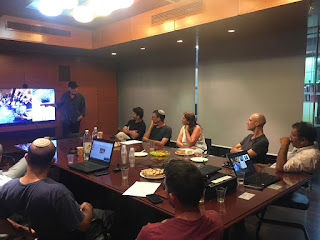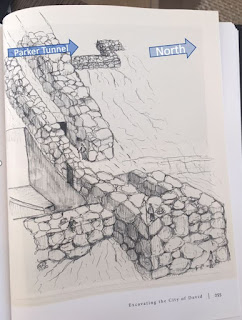From the excavation
report by MacAlister and Duncan - Excavations on the Hill of Ophel, Jerusalem 1923-1925:
"We thought, when they were first uncovered that they were cisterns and in the original draft of this report we described them as such. We have now definitely abandoned this theory. There is no trace of a water line on the walls. There is no cup-hollows such as usually exists in the bottom of rock-cut cisterns to catch the last dregs of the water. We now hold that these carefully hewn chambers were tombs of a very early date, presumably belonging to notable of the Jebusite city. In fact we have come to the conclusion that there are no Jebusite cisterns at all in the city, but that the Jebusite city was dependent entirely on the Virgins Fountain (and possibly other springs since dried up) for their water supply."
The statement above related to burial sites in
Field 5, but also 7
and 9 of the excavation, which is the upper east facing elevation along the north-south ridge of Mount Moriah (west of and between the modern Area G and E). It is testimony to the use of at least some of these areas as cultic worship sites established around sacred burial caves in the early and mid Bronze Age periods.
 |
| Presenting my tomb theory to members of the Israel Antiquity Authority |
The vigil seen at sacred grave sites in Israel today may resemble an early form of the tradition that continues by devotees who recite psalms and other prayers at the place the spirit of the deceased returns.
 |
| Prayer vigil at Joseph's tomb |
As I have
previously written, shaft tombs were common in the
region during the early through middle Bronze Age. Arguably Jerusalem's most ancient and important tomb may have existed for 1000 years or more before it was hacked when an Iron Age quarry cut the north-south passage on the lower eastern slope of the mountain. The path between two significant Bronze Age features, the
upper floor blocked cave and the lower floor cave house (Parker), that exists either side of the quarry may have been purposely separated in order to prevent ("stop or cancel" - see video) the continuous traditions of occupation and organized worship.
 |
Plan of Gihon excavations
The Rock-cut pool disconnected bidirectional north-south access |
Along the rim of the quarry the slope of the bedrock's south face can be seen below. It is now known that water could not be contained in the quarry because the low degree geophysical slope from the Gihon spring, north of the quarry could never build sufficient hydraulic pressure to raise water into any section of it.
 |
| Cut quarry often confused as - upper Gihon Pool |
The remnant round chamber (as it is known today) is contained in the bedrock of the rock-cut quarry visible below. It may once have been a much taller shaft connecting the burial chamber at the base to the surface (as illustrated top left of image).
 |
| Remnant of shaft to round chamber in rock-cut quarry |
The confirmed discovery of early and mid-bronze burial sites, in vicinity on the eastern slopes of Mount Moriah, as it descends toward the Kidron Valley and Gihon spring offer strong support for the theory that the round chamber in the rock-cut quarry once was a shaft-tomb leading to a sacred burial chamber. Eventually, at its base the abandoned burial chamber was connected to the Gihon Spring source through a series of cut channels.
On the adjacent, north face of the quarry the partly collapsed massive bronze age double wall rises from the east, near the Kidron Valley up the steep bedrock slope to the west. At the top (west), the double wall once connected with the city wall built at the time of King Hezekiah to further and completely block passage from north to south. around 100 years ago Montague Parker cleared sections of the wall to provide passage through a tunnel as seen in the next two images.
 |
| Double Wall looking east - quarry to the immediate south. |
 |
Top of wall was dismantled by Parker - looking north
(Kevin's gate can be seen in background left). |
Before it was dismantled by Parker, the top of the double wall abutted the city wall, which in conjunction with the quarry entirely blocked the north to south passage across the lower section of the east face above the Gihon Spring. In addition to sacred graves, we need to understand the time periods and long-standing motivations to undertake this massive construction.
 |
Drawing (looking to the west) from Ronnie Reich's book
demonstrates how the double wall, above the
Fortress of Zion and quarry blocked passage. |
|
Parker dismantled the top section of the double wall, that abutted the city wall to obtain access room 3 and 4, (image below) but he never made it to the adjacent rooms 2 and 1, they were discovered in 2011 by Eli Shukron.
 |
| Temple Zero complex facing east near the Gihon Spring |
If these four rooms comprised a Bronze Age
temple, the quarry, double walls and city wall may have been specifically constructed to prevent successive populations from practicing sacred rites in the four rooms. Herein may lie the long-standing negative motivation to construct such significant barriers that surround this important four room feature and prevent its use.
As
MacAlister and Duncan suggested in their detailed report the story of the
Lame and the Blind at the Fortress of Zion may further explain such long-standing motivations. The fortress refers to the stone construction immediately south of the Gihon Spring, extending west up the steep east face of Mount Moriah.
 |
All city walls depicted in this image
have not been located in archaeology |
This Jebusite fortress is referred to in 2 Samuel 5:7-8 and 1 Chronicles 11:5. King David's troops entered, captured and lived in the fortress until they eventually took control of the broader areas and the surrounding populations on the mountain. According to the Biblical accounts, surprisingly the Jebusite King was never forced to vacate Mount Moriah. During King David's 40 year reign at the same location the Jebusite Kings other property rights were upheld.
According to tradition the Lame and the Blind refers to the pacts between Abraham, Isaac and the descendants of Philistine progenitor Avimelech, as inherited by Jacob. These pacts permitted the Jebusites rights to occupy land in this region. King David allegedly broke the 500+ year "Lame and Blind" pact when his troops conquered the fortress and renamed it and the mountain the City of David.
The fortress and walls preceded Iron Age King David, by at least several hundred years. Therefore, the Bronze Age burial sites in the immediate vicinity may have motivated the Fortress, quarry and double wall obfuscation of the Temple Zero complex as a reminder to Israel of their paternal "Lame and Blind" pact with Jebusites. In this context "Lame" refers to Jacob who was lamed during his tussle with his "angel of death" brother Esau while en route back to the matzevah he erected 20 years earlier in the place he named Beit El, on Mount Moriah, the night he experience his famous "Jacob's Ladder" dream. Unlike room 3 of Temple Zero, which was purposefully constructed to retain the bedrock platform in its northwest corner, room 2 was empty until, post construction the perfectly preserved matzevah was located on its bedrock.
The Israel Antiquities Authority have agreed to investigate using geophysical probes and other methods that may reveal how or if it is affixed to bedrock. Regardless, its preservation in rooms that were sealed when discovered in 2011 is nonetheless remarkable.
 |
| Matzevah of Jacob on Mount Moriah |





